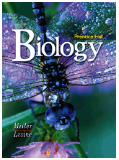BIOLOGY
by Miller & Levine
[complete Table of Contents]

|
Use the pull-down menu to jump to any of the Book's 40 Chapters: |
Additional Resources:
In this chapter, students will read about the general characteristics, life cycles, and major types of worms and mollusks. They will also read about the importance of some types of worms as parasites of humans.
| Hot Links | Chapter Self-Test |
| Take it to the Net | Teaching Links |
What are Web Codes? |
Web
Codes for Chapter 27: |
![]()
Section
27-1: Flatworms
![]() Flatworms are
soft, flattened worms that have tissues and internal organ systems. They
are the simplest animals to have three embryonic germ layers, bilateral
symmetry, and cephalization.
Flatworms are
soft, flattened worms that have tissues and internal organ systems. They
are the simplest animals to have three embryonic germ layers, bilateral
symmetry, and cephalization.
![]() Turbellarians
are free-living marine or freshwater flatworms.
Turbellarians
are free-living marine or freshwater flatworms.
![]() Flukes are parasitic
flatworms that usually infect the internal organs of their hosts.
Flukes are parasitic
flatworms that usually infect the internal organs of their hosts.
![]() Tapeworms are
long, flat, parasitic worms that are adapted to life inside the intestines
of their hosts.
Tapeworms are
long, flat, parasitic worms that are adapted to life inside the intestines
of their hosts.
Section
27-2: Roundworms
![]() Roundworms are
unsegmented worms that have pseudocoeloms and digestive systems with two
openings—a mouth and an anus.
Roundworms are
unsegmented worms that have pseudocoeloms and digestive systems with two
openings—a mouth and an anus.
![]() Parasitic roundworms
include trichinosis-causing worms, filarial worms, ascarid worms, and
hookworms.Section 27-3: Annelids
Parasitic roundworms
include trichinosis-causing worms, filarial worms, ascarid worms, and
hookworms.Section 27-3: Annelids
![]() Annelids are worms
with segmented bodies. They have a true coelom that is completely lined
with mesoderm.
Annelids are worms
with segmented bodies. They have a true coelom that is completely lined
with mesoderm.
![]() Oligochaetes are
annelids that typically have only a few setae and live in soil or fresh
water.
Oligochaetes are
annelids that typically have only a few setae and live in soil or fresh
water.
![]() Leeches are typically
external parasites that suck the blood and body fluids of their host.
Leeches are typically
external parasites that suck the blood and body fluids of their host.
![]() Polychaetes are
marine annelids that have paired, paddlelike appendages tipped with setae.
Polychaetes are
marine annelids that have paired, paddlelike appendages tipped with setae.
Section
27-3: Annelids
![]() Annelids
are worms with segmented bodies. They have a true coelom that is completely
lined with mesoderm.
Annelids
are worms with segmented bodies. They have a true coelom that is completely
lined with mesoderm.
![]() Oligochaetes are annelids that typically have only a few setae and live
in soil or fresh water.
Oligochaetes are annelids that typically have only a few setae and live
in soil or fresh water.
![]() Leeches are typically external parasites that suck the blood and body
fluids of their host.
Leeches are typically external parasites that suck the blood and body
fluids of their host.
![]() Polychaetes are marine annelids that have paired, paddlelike appendages
tipped with setae.
Polychaetes are marine annelids that have paired, paddlelike appendages
tipped with setae.
Section
27-4: Mollusks
![]() Mollusks are soft-bodied
animals that usually have an internal or external shell.
Mollusks are soft-bodied
animals that usually have an internal or external shell.
![]() The typical mollusk
body plan has four parts: foot, mantle, shell, and visceral mass.
The typical mollusk
body plan has four parts: foot, mantle, shell, and visceral mass.
![]() Gastropods are
shell-less or single-shelled mollusks that move by using a muscular foot
located on the ventral side.
Gastropods are
shell-less or single-shelled mollusks that move by using a muscular foot
located on the ventral side.
![]() Bivalves have
two shells that are held together by one or two powerful muscles.
Bivalves have
two shells that are held together by one or two powerful muscles.
![]() Cephalopods are
typically soft-bodied mollusks in which the head is attached to a single
foot. The foot is divided into tentacles or arms.
Cephalopods are
typically soft-bodied mollusks in which the head is attached to a single
foot. The foot is divided into tentacles or arms.